
Davis, Aron. The Poker Blueprint
.pdf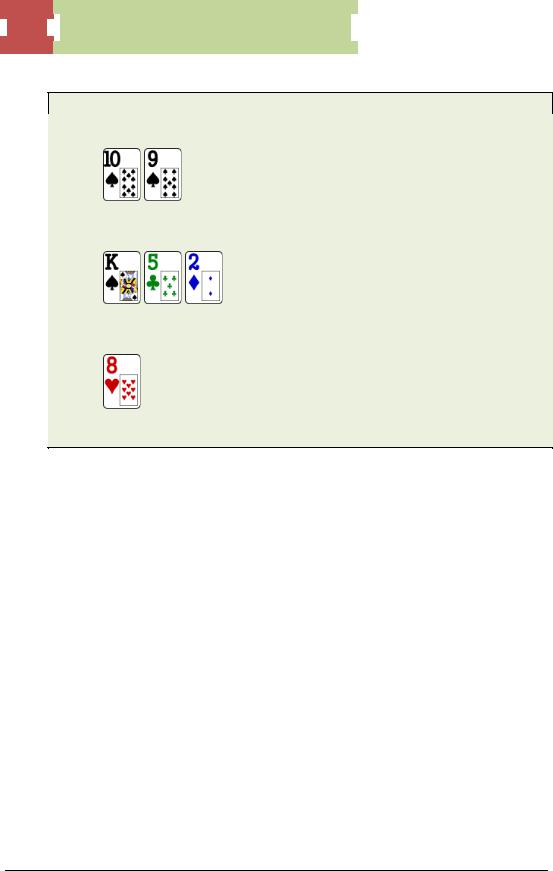
 89
89  Postflop: Time to Play Poker
Postflop: Time to Play Poker
100 NL – 6 max. 100BB effective stacks.
A TAG open-raises to $4 in MP and you call from the BTN with
The flop is
He bets 2/3-pot and you call. Turn is an
He bets 2/3-pot.The most optimal play is to…
Fold. This is probably the most important factor regarding floating. You don’t have to take down all the pots. Sometimes, there’s nothing you can do and you have to fold. That’s fine, and it doesn’t make you a bad player. Being a good player is all about making the play with the greatest EV. In this case, you maximize your EV by folding.
© 2010 Aaron Davis and Tri Nguyen - All Rights Reserved.
http://www.DailyVariance.com
89
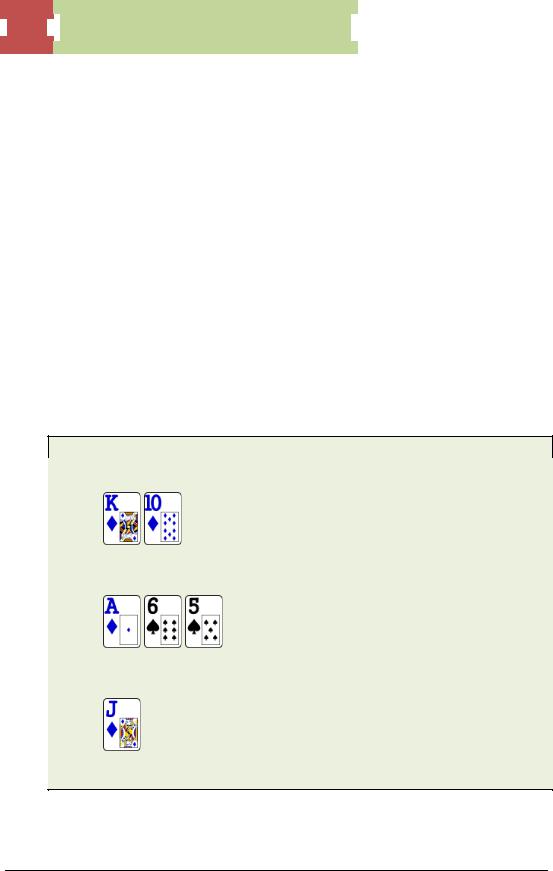
 90
90  Postflop: Time to Play Poker
Postflop: Time to Play Poker
Double-Barreling
The turn is the one street that most players at the lower limits have trouble with. The problem stems from players making plays on the flop without a plan for future streets.
For example, they bet with KT on Ac6s5s and don’t know what to do on various turn cards. Whether you check, bet, call or raise, plan your actions before the next card falls. You generally want to fire again on the turn if either of these conditions exists:
1.Your equity improves
2.A scare card hits
Let’s say you c-bet the flop as the pre-flop raiser and pick up a draw on the turn (flush draw, open-end, gutshot + overcard). Bet again to try to take down the dead money in the pot. A second barrel will look strong and increase your chances of winning without a showdown. On boards where a turn puts more draws out there, I will bet the river as well.
For example:
100 NL – 6 max. 100BB effective stacks. You bet with
on a flop of
The turn is a
You bet again and get called. You should seriously consider bluffing the river.
© 2010 Aaron Davis and Tri Nguyen - All Rights Reserved.
http://www.DailyVariance.com
90
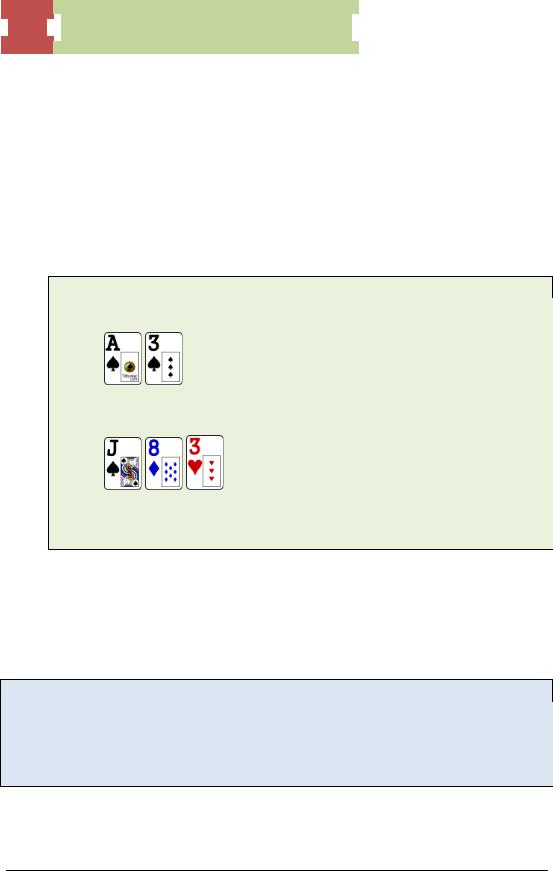
 91
91  Postflop: Time to Play Poker
Postflop: Time to Play Poker
The turn creates a lot of draws. Villain is likely to have a made weak hand or a draw. If he had a strong hand, he would’ve raised the turn to protect it. Therefore, a river bluff is profitable.
A great turn card that allows you to fire the river is an 8d (or any card that puts a straight out there) because it often gives Villain a pair with a draw that he will continue with on the turn and fold on the river, giving you more dead money.
Another example:
100 NL – 6 max. 100BB effective stacks. Suppose you open-raise to $3 with
from the button and a good player calls from the SB. The flop is
and he check-calls your c-bet. The turn is any spade besides a J or 8. He checks to you. What do you do?
Bet again. Villain will occasionally show up with sets and two pair here, but his range consists primarily of medium pairs and straight draws. You can safely exclude most overpairs from his range because he would 3-bet preflop or check-raise the flop. A turn bet would fold out 3x, 8x, and pocket pairs below a jack that don’t make a set. More importantly, you now have 14 outs (3 Aces, 2 threes, 9 spades) to make the best hand.
Important Note: A turn J or 8 isn’t a good barrel card because it narrows your valuebetting range to trips and sometimes overpairs. That’s a very small part of your range. A good player will realize this and call again with a stubborn pair. Sometimes, he’ll have a boat or trips here as well. Since you have showdown value against open-end draws and gutshots, checking behind is an option.
© 2010 Aaron Davis and Tri Nguyen - All Rights Reserved.
http://www.DailyVariance.com
91
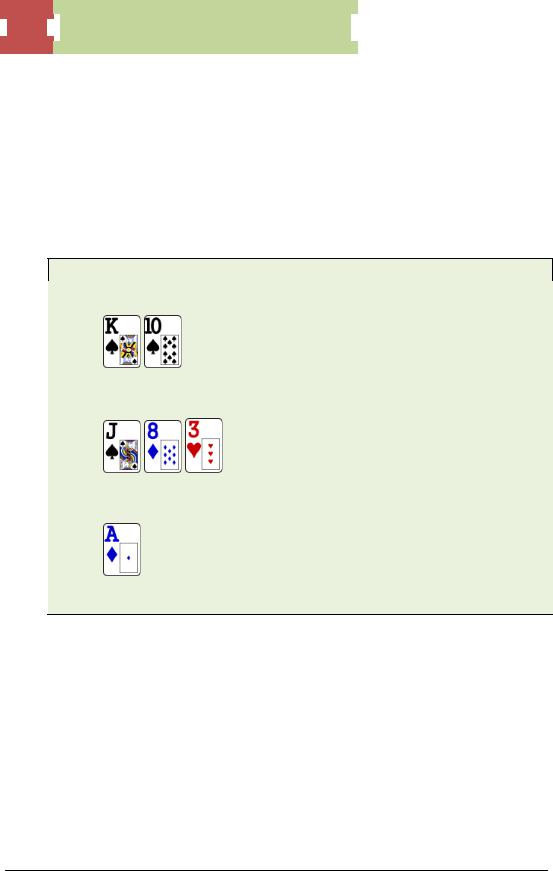
 92
92  Postflop: Time to Play Poker
Postflop: Time to Play Poker
Scare Card
A scare card improves one player’s perceived range and decreases another’s perceived range. In other words, it makes the board look more dangerous for one of the players in the pot. Overcards and flush cards are some of the most common scare cards that players like to barrel on (straight draws are more subtle, and thus harder to rep). Scare cards also provide great opportunities to multi-barrel and apply tremendous pressure on your opponents. The classic example is the ace.
100 NL – 6 max. 100BB effective stacks. You open raise to $3 with
on the button and SB calls. The flop is
He check-calls your half-pot bet. The turn is the
The best play is to …
Bet again. The Ace hits your perceived range more than Villain’s because 1) you raised pre-flop and 2) he would have 3-bet a strong Ace before the flop. You also picked up a gutshot draw to the nuts. A river K or T may give you the best hand as well.
There is another way to play a turn ace when you are in position. You can check behind to represent a small Ace going for pot control, and then bet the river if it gets checked to you again. Betting the turn is usually better than checking behind, since your opponent will check-fold the turn often.
The king is another great scare card.
© 2010 Aaron Davis and Tri Nguyen - All Rights Reserved.
http://www.DailyVariance.com
92
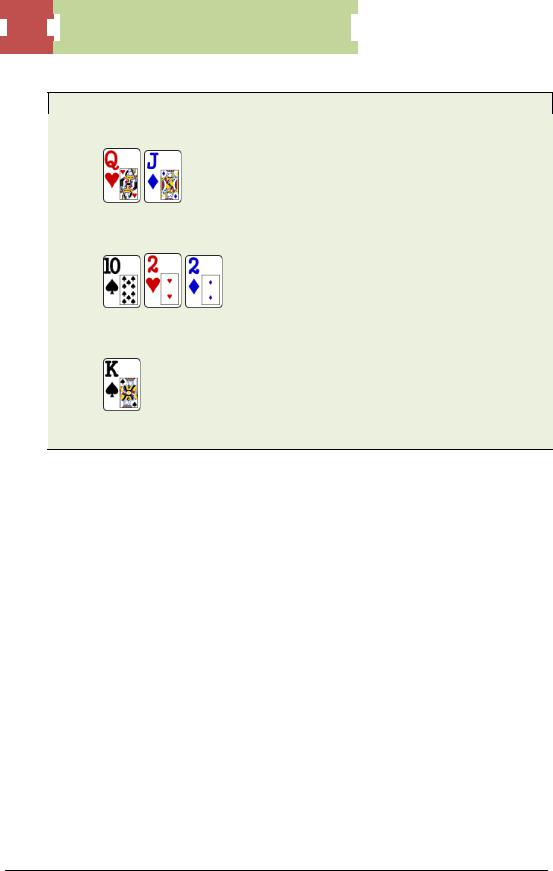
 93
93  Postflop: Time to Play Poker
Postflop: Time to Play Poker
100 NL – 6 max. 100BB effective stacks.
You open-raise to $3 from the BTN with
and BB calls. You c-bet 2/3-pot on
The turn is a
You should fire again.
The king is one of the best cards in the deck to barrel on because it hits your range more than his. In this scenario, it’s actually better than an ace because players sometimes check-call the flop with ace-high hands like AQ/AJ. Had the turn been an ace, you would have continued bluffing (and rightfully so). There is also less Kx in your opponent’s checkcalling range. Another important factor regarding a high turn card is that Villain will checkfold a lot of small pocket pairs that he check-called with on the flop. For these reasons, this is a good time to bet the turn.
The worst cards to double-barrel on are ones that pair the board, because you are less likely to have trips or a boat.
Consider the following example:
© 2010 Aaron Davis and Tri Nguyen - All Rights Reserved.
http://www.DailyVariance.com
93

 94
94  Postflop: Time to Play Poker
Postflop: Time to Play Poker
100 NL – 6 max. 100BB effective stacks.
You open raise to $3.50 from MP with
A good TAG player calls from the BTN and the flop is
You bet 3/4-pot and he calls. The turn is a
and you bet again.
If you never double barrel with 88-99 and JJ+ in this spot, your hand range is very polarized toward complete bluffs and trips. It becomes more unlikely that you have a T in your hand with two on the board. So 99, 88 or 7x will likely call another barrel.
Let’s say the turn is a 7 that pairs the middle card. His range now improves. All top-pair hands will call, 88-99 might call also, all trips call or raise and Villain has the option of bluff-raising to rep trips. Not a great spot to be bluffing.
What if the turn pairs the bottom card? It’s a relatively safe card for him because the board hasn’t changed much. If he has top or middle pair, then he still has the same hand. It also makes it less likely for you to have bottom set due to hand combinations.
The Problem of Scare Cards
In today’s games, many people know what the obvious scare cards. For this reason, your bet is less credible on that particular scare card and you usually need to fire another bullet to take down the pot. Fortunately, people call on the scare card and fold to a river bet all the time.
You can balance your range in this spot by betting your medium-strength hands. For example, you c-bet on a T52r flop with Tx and JJ-KK. If the turn is an ace, you should
© 2010 Aaron Davis and Tri Nguyen - All Rights Reserved.
http://www.DailyVariance.com
94

 95
95  Postflop: Time to Play Poker
Postflop: Time to Play Poker
consider betting as well. This widens your value-range on the turn and you can safely fold against a check-raise. Curious opponents might check-call on the turn with hands such as 44, 54, and sometimes pocket pairs lower than TT.
Betting on the turn also lets your opponent know that he can’t simply put you on air when you bet on a turn ace. He’ll second-guess himself the next time he decides to call with 66-99 and 7x, and even a weak T in this situation.
This same concept can be applied for cards other than a turn ace. You can still value-bet with Tx on a turn J, Q, and K. Against opponents who check-raise the turn with a wide range, I would frequently check behind on the turn. Checking behind makes the hand easier to play and prevents you from being bluffed. Although an argument can be made for making the most EV play, it’s sometimes better to sacrifice a little EV to make your life easier and, more importantly, to prevent you from making a costly mistake.
An alternative to betting on the turn is to check behind the turn ace and value-bet the river (or bluff if you don’t have a hand with showdown value). You can credibly represent a medium pair or a small ace going for pot control on the turn and betting for thin value on the river.
Implied Threat of the River Bet
Another reason to double-barrel the turn is the implied threat of the river bet. The threat of losing a stack causes players to err on the side of caution, causing them to fold their marginal holdings on the turn. This puts their turn range face-up and makes it easier for you to play against them on future hands. I can’t recall how many times I’ve check-called the turn with a marginal hand because I knew my opponent would give me a free showdown at the river. Most players below 100NL don’t have the skills (or guts) to fire that last bet on the river. This is especially true if it is a big river bet. For this reason, you should incorporate bluffing the river into your game.
Having a reputation for not giving free showdowns allows you to take tons of uncontested pots because they know you have a few more bullets waiting for them in later streets. It’s not fun when you call with a mediocre hand on the turn and you don’t know what to do against a river bet that can possibly be an all-in.
The implied threat of the river bet is what makes position so important. You control whether you take a free showdown or not.
© 2010 Aaron Davis and Tri Nguyen - All Rights Reserved.
http://www.DailyVariance.com
95

 96
96  Postflop: Time to Play Poker
Postflop: Time to Play Poker
Strong hands (two pair or better)
As players keep improving, it gets tougher to “trap” players into stacking off with marginal holdings. The best way to get value out of your strong hands is to bet, especially when players like to call. A common mistake I see is to slow-play monster holdings. That’s not to say slow-playing is bad. There is certainly a time and place for it. However, unless a player has been very aggressive, you should bet and play your strong hands fast on all streets. There are many reasons for this.
It is easier to balance a betting range than a check-calling range. Betting balances the times when you have a hand and when you have nothing. You can’t really check-call with nothing. Well, you can, but it isn’t going to be profitable.
Some players like to check-raise the turn as well. An observant opponent will realize how unbalanced your check-raising range is on the turn. I construct my opponent’s checkraising range by observing the hands he shows down when he check-raises the turn. If I see a strong hand, I note that he check-raises the turn with a strong hand. This means that when he’s 2-barrelling, he’s more likely to have a draw. Of course, that is a simple read, and I adjust my estimated range for him as I see more hands. On the other side, if an opponent check-raises the turn and I see a draw at showdown, it tells me that he’s the type of player who likes to take a free card rather than bet his draw. As you can see, it’s easier for me to construct his turn range when he check-raises the turn. If my opponent were to bet the turn with the majority of his turn range, I wouldn’t know what to do. Sometimes he has a draw with outs against my marginal holding; sometimes he has a strong hand that crushes my marginal holding. Against that range, I have to fold if he bets the turn.
A simple example:
© 2010 Aaron Davis and Tri Nguyen - All Rights Reserved.
http://www.DailyVariance.com
96
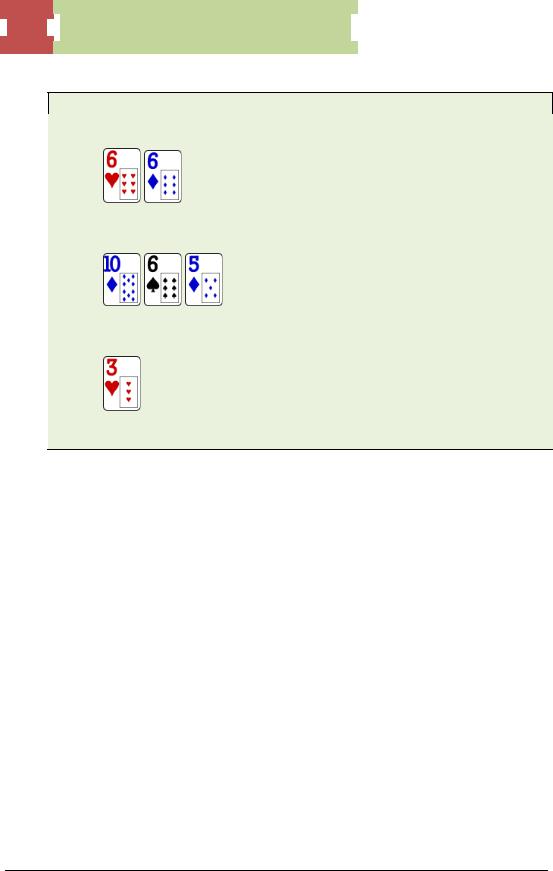
 97
97  Postflop: Time to Play Poker
Postflop: Time to Play Poker
100 NL – 6 max. 100BB effective stacks. You open-raise pre-flop to $4 with
from MP and BTN calls. The flop is
You bet 3/4-pot and he calls. The turn is a
You should almost always bet here.
Some players like to check-raise in this spot because they want to trick their opponents into betting Tx or better. But Tx or better is going to call your turn bet anyway. In some cases, those hands might shove the turn to protect their hands. But by checking, you give a free card. Many of his hands are medium pairs that will check behind. These medium pairs may have also picked up a straight draw (76, 75, 64, and 54). He would have called a bet with weak pairs, pair + draws and maybe flush draws. If the turn is checked through, the river can come a diamond or straight card, which might cause you to make an incorrect decision. Betting out also balances all those times you double-barrel with your flush draws or a hand like 87.
Top pair
Playing top pair, good kicker against the pre-flop raiser can be tricky. Against the majority of players, the flop is a check-call. And with enough history, you can call off your stack with top pair, good kicker. There are a few factors that you should consider.
1.There’s a huge difference between having a top pair such as KQ on QT5 rainbow and AT on T84 rainbow. There are not many overpairs on QT5. Thus, KQ is an easier stack-off than AT.
© 2010 Aaron Davis and Tri Nguyen - All Rights Reserved.
http://www.DailyVariance.com
97
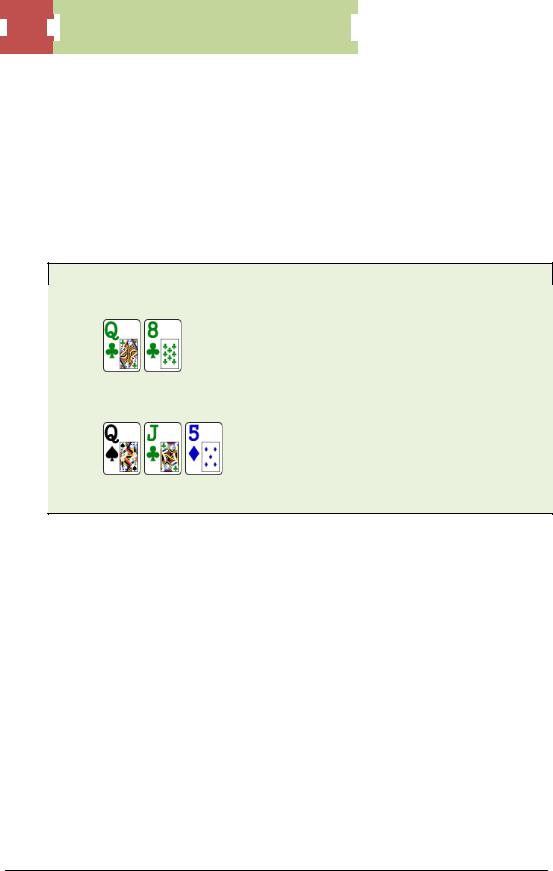
 98
98  Postflop: Time to Play Poker
Postflop: Time to Play Poker
2.How wide is your check-raising range? If you rarely check-raise with draws or bluffs, then you should consider check-calling with both those hands because, when you check-raise for value, those holdings are actually the bottom of your value range. Worse hands are rarely paying you off. Additionally, players are less likely to play back at you because you have a narrow check-raising range.
A quick example:
100 NL – 6 max. 100BB effective stacks.
A tricky player open-raises to $3 on the BTN and you call with
from the big blind. The flop is
You check and Villain bets 3/4-pot. What is your action?
Check-call is by far the most common and best play. Check-raising over-represents your hand, and it’s hard to imagine a hand such as JT calling your check-raise. However, that doesn’t mean you should check-call this flop all the time. If you have been active post-flop after defending from the blind, you can profitably check-raise this flop and continue betting the turn and river for value. However, it is important that you recognize the history between you and your opponent if you want to take an aggressive line for value with a good but not great hand. Some players tend to think their image is crazier than it really is. Or they over-think how their opponents are going to react. Misreading the situation will cause you to overplay your hand and you will end up spewing.
Going off on a tangent, you should consider check-raising a lot at microand small-stakes games. For example, if I had 65 clubs instead of Q8 clubs in the above example, I would check-raise and fold to a 3-bet instead of check-calling. There are many reasons for this.
© 2010 Aaron Davis and Tri Nguyen - All Rights Reserved.
http://www.DailyVariance.com
98
